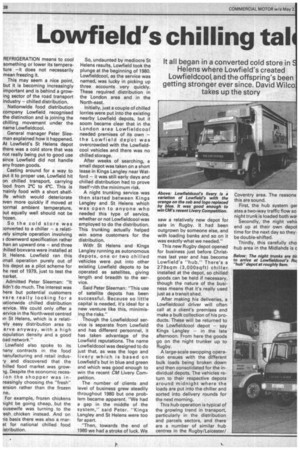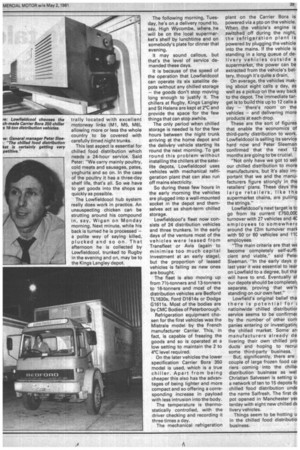Lowfield's chilling tal
Page 48

Page 49

If you've noticed an error in this article please click here to report it so we can fix it.
It all began in a converted cold store in Helens where Lowfield's created Lowfieldcool,and the offspring's been getting stronger ever since. David Wilco takes up the story
REFRIGERATION means to cool something or lower its temperature —it does not necessarily mean freezing it.
This may seem a nice point, but it is becoming increasingly important and is behind a growing sector of the road transport industry — chilled distribution.
Nationwide food distribution company Lowfield recognised the distinction and is joining the chilling movement under the name Lowfieldcool.
General manager Peter Sleeman explained how it happened. At Lowfield's St Helens depot there was a cold store that was not really being put to good use since Lowfield did not handle any frozen goods.
Casting around for a way to put it to proper use, Lowfield hit on chilled transport, carrying 'ood from 2°C to 4°C. This is -nainly food with a short shelfife which would deteriorate ?.ven more quickly if moved at lormal ambient temperature, Dut equally well should not be !rozen.
So the cold store was 3onverted to a chiller — a relatirely simple operation involving 3 downward specification rather han an upward one — and three thilled boxvans were installed at ;t Helens. Lowfield ran this ;mall operation purely out of his depot as a pilot scheme for he rest of 1979, just to test the narket.
Admitted Peter Sleeman: "It lidn't do much. The interest was here but potential customers vere really looking for a iationwide chilled distribution .ervice. We could only offer a ervice in the North-west centred in St Helens, which is a relati.eiy easy distribution area to erve anyway, with a high iopulation density and a good oad network."
Lowfield also spoke to its any contracts in the food ianufacturing and retail indus-y and discovered that the hilled food market was grow1g. Despite the economic recesion the shopper was inreasingly choosing the "fresh" ersion rather than the frozen ne.
For example, frozen chickens light be going cheap, but the ousewife was turning to the .esh chicken instead. And on us basis there was also a maret for national chilled food istribution.
So, undaunted by mediocre St Helens results, Lowfield took the plunge at the beginning of 1980. Lowfieldcool, as the service was named, was lucky in picking up three accounts very quickly. These required distribution in the London area and in the North-east.
Initially, just a couple of chilled lorries were put into the existing nearby Lowfield depots, but it soom became clear that in the London area Lowfieldcool needed premises of its own — the Lowfield deo...at was overcrowded with the Lowfieldcool vehicles and there was no chilled storage.
After weeks of searching, a small depot was taken on a short lease in Kings Langley near Watford — it was still early days and chilled distribution had to prove itself viith the minimum risk.
A night trunking service was then started between Kings Langley and St Helens which was open to anyone who needed this type of service, whether or not Lowfieldcool was employed to do the distribution. This trunking actually helped win some customers for the distribution.
With St Helens and Kings Langley running as autonomous depots, one or two chilled vehicles were put into other existing Lowfield depots to be operated as satellites, giving length and breadth to the service.
Said Peter Sleeman: "This use of satellite depots has been successful. Because so little capital is needed, it's ideal for a new venture like this, minimising the risks."
Though the Lowfieldcool service is separate from Lowfield and has different personnel, it has taken advantage of the Lowfield reputations. The name Lowfieldcool was designed to do just that, as was the logo and livery which is based on Lowfield's but in blue and green and which was good enough to win the recent CM Livery Competition.
The number of clients and level of business grew steadily throughout 1980 but one problem became apparent. "We had a gap in the middle of the system," said Peter. "Kings Langley and St Helens were too far apart.
"Then, towards the end of 1980 we had a stroke of luck. We saw a relatively new depot for sale in Rugby. It had been outgrown by someone else, and with loading banks and so on it was exactly what we needed."
This new Rugby depot opened for business just before Christmas last year and has become Lowfield's "hub," There's a 2799qm (3,000sqf0 chiller installed at the depot, so chilled goods can be held if necessary, though the nature of the business means that it's really used just as a transit shed.
After making his deliveries, a Lowfieldcool driver will often call at a client's premises and 'make a bulk collection of his products. These will be returned to the Lowfieldcool depot — say Kings Langley — in the late afternoon. From here the goods go on the night trunker up to Rugby.
A large-scale swopping operation ensues with the different bulk loads being broken down and then consolidated for the individual depots. The vehicles return to their respective depots around midnight where the loads are put into the chiller and sorted into delivery rounds for the next morning.
This hub operation is typical of the growing trend in transport, particularly in the distribution and parcels sectors, and there are a number of similar hub centres in the Rugby/Leicester/ Coventry area. The reasons this are sound.
First, the hub system gel ates a two-way traffic flow so night trunk is loaded both wal Secondly, the night vehit end up at their own depot time for the next day so they be double-shifted.
Thirdly, this carefully chi:" hub area in the Midlands is c trally located with excellent motorway links (M1, M5, M6), allowing more or less the whole country to be covered with carefully timed night trunks.
This last aspect is essential for chilled food distribution which needs a 24-hour service. Said Peter: "We carry mainly poultry, cold meats and sausages, pates, yoghurts and so on. In the case of the poultry it has a three-day shelf life, that's all. So we have to get goods into the shops as quickly as possible.
The Lowfieldcool hub system really does work in practice. An unsuspecting chicken can be strutting around his compound in, say, Wigan on Monday morning. Next minute, while his back is turned he is processed — a polite way of saying killed, plucked and so on. That afternoon he is collected by Lowfieldcool, trunked to Rugby in the evening and on, may be to the Kings Langley depot. The following morning, Tuesday, he's on a delivery round to, say, High Wycombe, where he will be on the local supermarket's shelf by lunchtime and on somebody's plate for dinner that evening.
It may sound callous, but that's the level of service demanded these days.
It is because of the speed of the operation that Lowfieldcool can operate its six satellite depots without any chilled storage — the goods don't stop moving long enough to justify it. The chillers at Rugby, Kings Langley and St Helens are kept at 2°C and provide the space for the few things that can stop awhile.
The only period when chilled storage is needed is for the few hours between the night trunk arriving at the home depot and the delivery vehicle starting its round the next morning. To get round this problem without installing the chillers at the sateilite depots, Lowfieldcool uses vehicles with mechanical refrigeration plant that can also run off mains electricity.
So during these few hours in the early morning the vehicles are plugged into a wall-mounted socket in the depot and themselves act as short-term chilled storage.
Lowfieldcool's fleet now consists of 24 distribution vehicles and three trunkers. In the early days of the venture most of the vehicles were leased from Transfleet or Avis (again to minimise too much capital investment at an early stage), but the proportion of leased vehicles is falling as new ones are bought.
The fleet is also moving up from 71/2-tonners and 13-tonners to 16-tonners and most of the distribution vehicles are Bedford TL1630s, Ford D1614s or Dodge G1611s. Most of the bodies are by CMC Bodies of Peterborough.
Refrigeration equipment chosen for the first vehicles was the Mistrale model by the French manufacturer Carrier. This, in fact, is capable of freezing the goods and so is operated at a low setting to maintain the 2 to 4°C level required.
On the later vehicles the lower specification Carrier Bora 350 model is used, which is a true chiller. Apart from being cheaper this also has the advantages of being lighter and more compact and so offering a corresponding increase in payload with less intrusion into the body.
The temperature is thermostatically controlled, with the driver checking and recording it three times a day.
The mechanical refrigeration plant on the Carrier Bora is powered via a pto on the vehicle. When the vehicle's engine is switched off during the night, the refrigeration plant is powered by plugging the vehicle into the mains, If the vehicle is standing in a long queue of delivery vehicles outside a supermarket, the power can be extracted from the vehicle's battery, though it's quite a drain.
On average, the vehicles making about eight calls a day, as well as a pickup on the way back to the depot. The immediate target is to build this up to 12 calls a day — there's room on the vehicles — and delivering more products at each drop.
These are the sort of figures that enable the economics of third-party distribution to work. Lowfieldcool is selling its service hard now and Peter Sleeman confirmed that the next 12 months are going to be crucial.
"Not only have we got to sell our chilled distribution to more manufacturers, but it's also important that we and the manufacturers figure strongly in the retailers' plans. These days the large retailers, like the supermarket chains, are pulling the strings."
Lowfieldcool's next target is to go from its current 050,00C turnover with 27 vehicles and 4C employees to somewhere around the £2m turnover mark with 50 or 60 vehicles and 11C employees.
"The main criteria are that WE become completely self-suffi. dent and viable," said Pete' Sleeman. "In the early days a last year it was essential to lear on Lowfield to a degree, but tha will have to end. Eventually al our depots should be complete') separate, proving that we'rE standing on our own feet."
Lowfield's original belief tha there is potential for nationwide chilled distributior service seems to be confirmec by the number of other corn panies entering or investigatinc the chilled market. Some an manufacturers already de livering their own chilled pro ducts and hoping to recrui some third-party business.
But, significantly, there are couple of large frozen food car riers coming into the chine' distribution business as wel Christian Salvesen is setting u a network of ten to 15 depots fc chilled food distribution uncle the name Salfresh. The first de pot opened in Manchester ye: terday with eight new chilled de livery vehicles.
Things seem to be hotting u in the chilled food distributio business.
















































































































